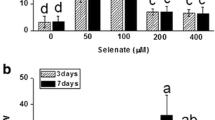Abstract
Sulfate and selenate compete for active transport across cell membranes via a common permease, suggesting that a significant interaction may exist between uptake of the two ions. The effect of sulfate on selenate uptake and toxicity in Selenastrum capricornutum was investigated using two sulfate levels (3.3 and 33 mg/L S, as SO4) and two selenate levels (10 and 100 μg/L Se, as SeO4). This provided four treatments: one with S:Se molar ratio of 75, two with molar ratios of 750, and one with a molar ratio of 7,500. Selenium uptake and toxicity analyses demonstrated antagonism between the two anions. Increasing sulfate resulted in significantly reduced selenate uptake and increased algal growth. There was a significant difference in selenate uptake between the two treatments with the same S:Se molar ratio suggesting different relative permease affinities for each of the ions at different substrate levels (i.e., above and below permease saturation levels) and/or the presence of two different permease systems. The environmental significance of sulfate and selenate antagonism is discussed.
Similar content being viewed by others
References
Barnhart RA (1957) Chemical factors affecting the survival of game-fish in a western Colorado reservoir. PhD Diss, Colorado St Univ, Ft Collins, CO
Besser JM, TJ Canfield, La Point TW (1993) Bioaccumulation of organic and inorganic selenium in a laboratory food chain. Environ Toxicol Chem 12:57–72
Coughlan S (1977) Sulphate uptake in Fucus serratus. J Exp Bot 28:1207–1215
Cumbie PM, VanHorn SL (1978) Selenium accumulation associated with fish mortality and reproductive failure. Proc SE Assoc Fish Wildl Agen 32:612–624
Cutter GA (1978) Species determination of selenium in natural waters. Anal Chim Acta 98:59–66
Deane EM, O'Brien RW (1975) Sulphate uptake and metabolism in the chrysomonad Monochrysis lutheri. Arch Microbiol 105:295–301
Deane EM, O'Brien RW (1981) Uptake of sulphate, taurine, cysteine, and methionine by symbiotic and free-living dinoflagellates. Arch Microbiol 128:311–319
Foe CG, Knight AW (1986) Selenium bioaccumulation, regulation and toxicity in the green alga Selenastrum capricornutum, and the dietary toxicity of the contaminated alga to Daphnia magna. In: Slocum D (ed) Selenium in the environment. California Agricultural Technology Institute, Fresno, CA, pp 77–88
Gillespie R, Baumann P (1986) Effects of high tissue concentrations of selenium on reproduction by bluegill. Trans Am Fish Soc 115:208–213
Heinz GH, Hoffman DJ, Gold LG (1988) Toxicity of organic and inorganic selenium to mallard ducklings. Arch Environ Contam Toxicol 17:561–568
Heinz GH, Hoffman DJ, Gold LG (1989) Impaired reproduction of mallards fed an organic form of selenium. J Wildl Manag 53:418–428
Jeanjean R, Broda E (1977) Dependence of sulphate uptake by Anacystis nidulans on energy, on osmotic shock and on sulphate starvation. Arch Microbiol 114:19–23
Kumar HD, Prakash G (1971) Toxicity of selenium to the blue-green algae, Anacystis nidulans and Anabaena variablis. Ann Bot 35:697–705
Kylin A (1967) The uptake and metabolism of sulphate in Scenedesmus as influenced by citrate, carbon dioxide, and metabolic inhibitors. Physiol Plant 20:139–148
Leggett JE, Epstein E (1956) Kinetics of sulfate absorption by barley roots. Plant Physiol 31:222–226
Lemly AD (1985) Toxicology of selenium in a freshwater reservoir: Implications for environmental hazard evaluation and safety. Ecotoxicol Environ Safety 10:314–338
Malchow D (1990) Toxicity and bioaccumulation of dietary selenium to the aquatic larvae of the midge, Chironomus decorus. MS thesis, University of California, Davis, CA
Nichols HW (1973) Growth media: Freshwater. In: Stein JR (ed) Handbook of phycological methods, culture methods, and growth measurements. Cambridge University Press, Cambridge, UK, pp 7–24
Ogle RS, Knight AW (1994) Bioaccumulation of selenium in aquatic ecosystems. 3. The roles of bioconcentration and biomagnification in the comparative bioaccumulation of selenate and selenite by fathead minnows (Pimephales promelas) and bluegill (Lepomis macrochirus). Manuscript in preparation
Ohlendorf HM, Hoffman DJ, Saiki MK, Aldrich TW (1986) Embryonic mortality and abnormalities of aquatic birds: Apparent impacts of selenium from irrigation drain water. Sci Total Environ 52:49–63
Presser TS, Barnes I (1984) Selenium concentrations in waters tributary to and in the vicinity of the Kesterson National Wildlife Refuge, Fresno and Merced Counties, California. Water Resources Investigations Report No. 84–4122, U.S. Geological Survey, Menlo Park, CA
Rybova R, Nespurkova L, Janacek K, Struzinsky R (1982) Sulphate-uptake isotherm of the alga Hydrodictyon reticulatum. Stud Biophys 3:123–126
Sarma YSRK, Jayarman S (1984) Observations on sulphur-selenium antagonism on the growth of two desmids. Acta Bot Indica 12:57–60
Shrift A (1954) Sulfur-selenium antagonism. I. Antimetabolite action of selenate on the growth of Chlorella vulgaris. Am J Bot 41:223–230
Shrift A (1973) Selenium compounds in nature and medicine. E. Metabolism of selenium by plants and microorganisms. In: Klayman DL, Gunther WHH (eds) Organic selenium compounds: Their chemistry and biology. Wiley-Interscience, NY, pp 763–814
Strickland JKH, Parsons TR (1972) A practical handbook of seawater analysis. Fisheries Research Board of Canada, Ottowa, Canada
Sturman BT (1985) Development of a continuous flow hydride and mercury vapor generation accessory for atomic absorption spectrophotometry. Appl Spectrosc 39:48–56
U.S. Environmental Protection Agency (1975) Methods for acute toxicity testing with fish, macroinvertebrates, and amphibians. EPA-660/3-75-009, Washington, DC
Wetzel RG (1983) Limnology, 2nd ed. Saunders College Publ, Philadelphia, PA
Woock SE, Garrett WR, Partin WE, Bryson WT (1987) Decreased survival and teratogenesis during laboratory selenium exposures to bluegill, Lepomis Macrochirus. Bull Environ Contam Toxicol 39:998–1005
Author information
Authors and Affiliations
Rights and permissions
About this article
Cite this article
Williams, M.J., Ogle, R.S., Knight, A.W. et al. Effects of sulfate on selenate uptake and toxicity in the green alga Selenastrum capricornutum . Arch. Environ. Contam. Toxicol. 27, 449–453 (1994). https://doi.org/10.1007/BF00214834
Received:
Revised:
Issue Date:
DOI: https://doi.org/10.1007/BF00214834




